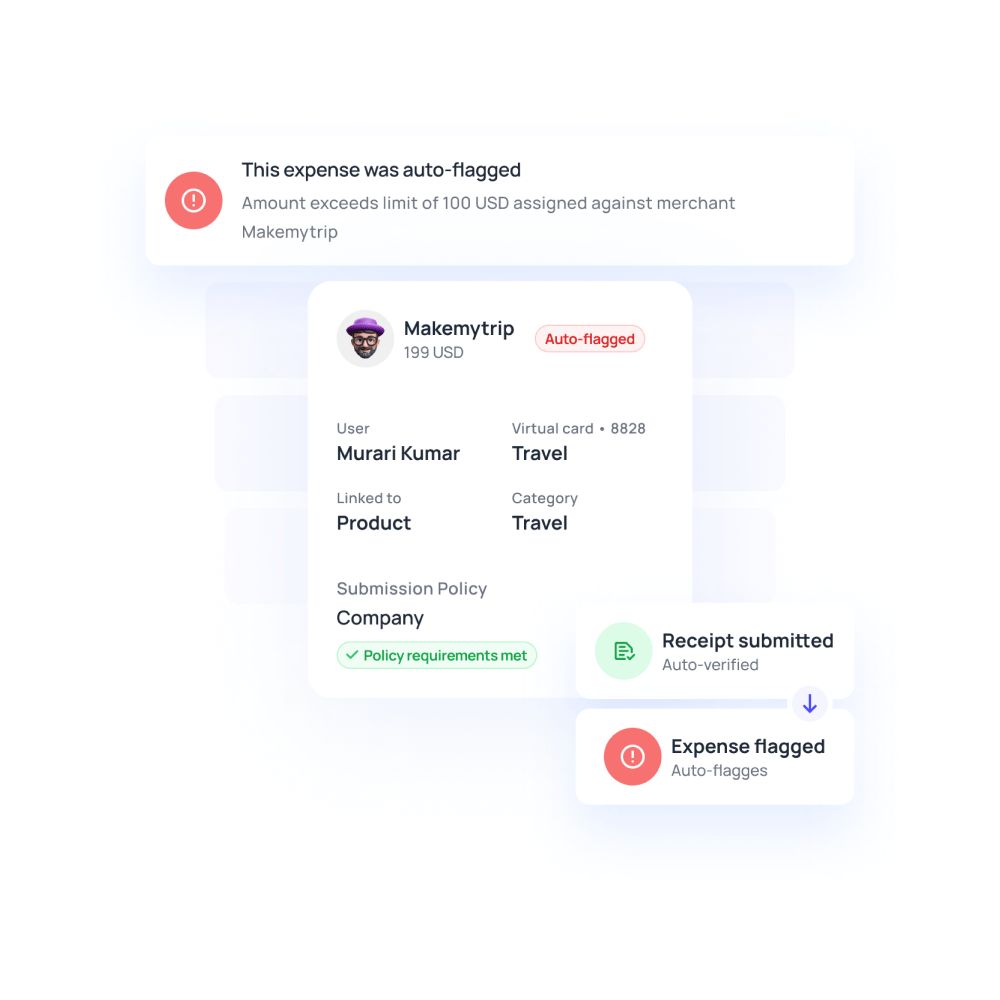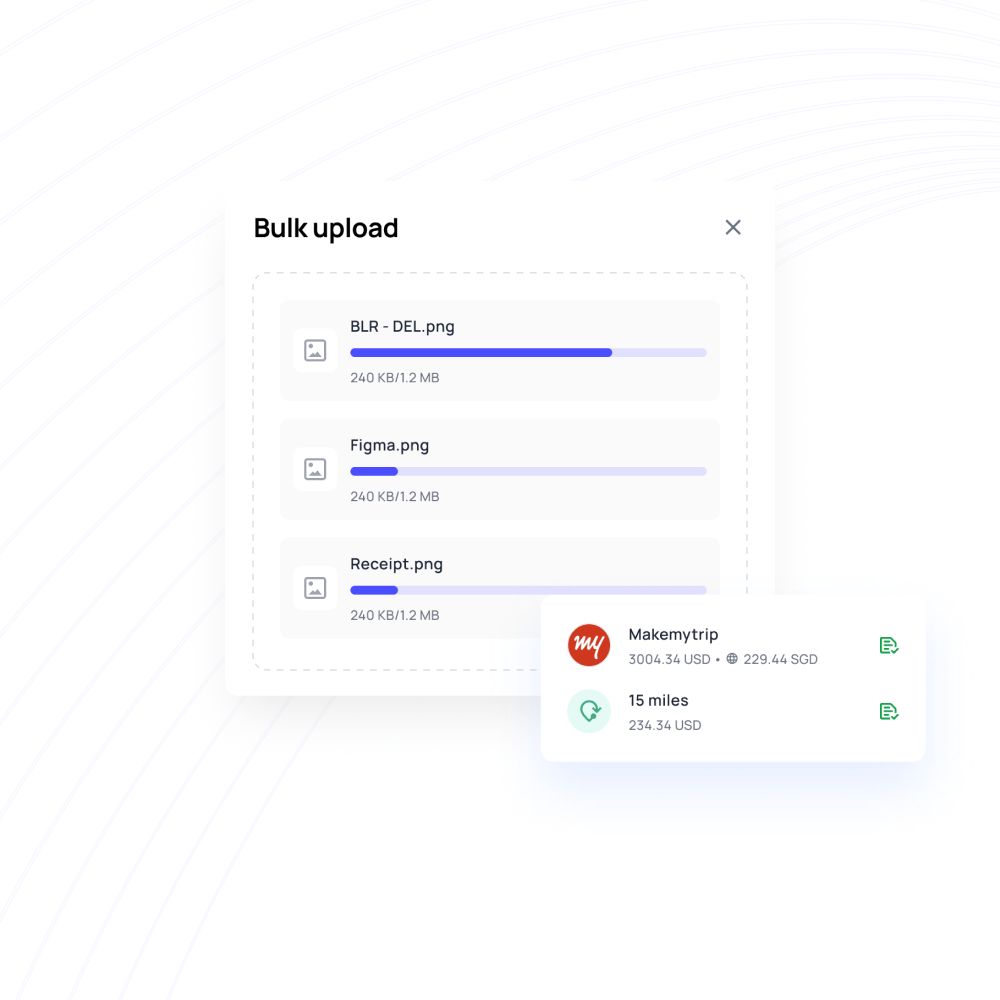Company expense policy: A complete guide for businesses
Whether you are an established company or a solopreneur expanding their team, you will agree that your employees are the most important asset of your business. They keep the gears running smoothly, allowing you to grow your vision and increase your profits. So when employees make out-of-pocket expenditures on business-related expenses, it is your responsibility to ensure that they get reimbursed on time.
But how do you communicate to your team what constitutes a business expense and what doesn’t? For that, you require an ironclad company expense policy to safeguard your interests and eradicate any lingering doubts in your employees’ minds as to how business expenses work in your organization and what factors do you need to consider when creating this policy?
What is business expense policy?
A business or corporate expense management policy is a set of rules laid down by your company that defines how your employees get reimbursed for the purchases they have made on the behalf of the company. It also dictates what does and does not constitute a business expense and works as both a rulebook and a guide for employees and business owners alike. From an employee perspective, having a company expense policy takes the guesswork out of recording expenses. From the get-go, your employees are aware of which purchases qualify for reimbursement and which don’t.

How to create a successful expense policy
You might be thinking that a good expense policy is like a twenty-page long strict rulebook, filled with every imaginable Dos and Don’ts, but it’s the opposite. A successful company expense policy is straightforward, structured, and easily understandable.
The devil might be in the details, but you aren’t meant to be. Don’t nitpick about every expense. Your expense policy is created to exclude any exceptions and form a systematic set of rules. An expense policy should convey the objective and the relevant processes in the simplest manner possible.
Having a structured and clean flow to your policy will make it easy for travel and expense policy compliance and locate specific rules should the need arise. The best way to go about it would be to organize your expense policy categorically such as the travel and expense process, meals and entertainment process, etc.
Ensure that your policy is up-to-date with not just your company culture but also the latest financial laws and guidelines relevant to your industry and/or country. Instead of using a lot of jargon, stick to easily understandable language that all your employees will greatly appreciate.
Challenges in company expense management policy
Businesses all over the world are experiencing the convenience of a paperless world, yet file paper expense reports. Paper-based expense reports are just as prone to error as any other paper document. You can easily lose them in a sea of paperwork, like paper receipts.
It’s more difficult to impose expense report compliance and company policy when they are not appropriately digitized. What’s worse, your finance team is burdened with the task of manually re-entering the claim value and additional data into the accounting system when it could all simply be automated.
Also read - Common expense report frauds to watch out
Filing expense claims is tiring for you, but it is equally burdensome for your employees. They store physical receipts and bills of work-related expenses and record them weeks and even months later, which means they have to keep these receipts safely if they want to be reimbursed at all.
Then there is your finance team, painstakingly keeping track of these paper receipts, spending weeks to just reconcile these reports, and ensuring that the employees get reimbursed. High-level authorities might not realize how big of an inconvenience these issues are.
A lax company expense policy gives way for employees to take undue advantage of your expense policy.
Although there should always be a sense of mutual trust between business owners and their employees, an expense policy with numerous loopholes will embolden employees to claim reimbursements higher than the actual expenses and for personal purchases too.
Must-haves in your business expense policy
Expense categories
Your policy should have clear expense categories for every type of work-related expenditure imaginable. You can divide these expense categories by department, role, nature of the expense, etc. Some categories to consider.
- Travel expenses.
- Travel-related expenses.
- Lodging expenses.
- Remote working expenses.
- Meals and Entertainment expenses
List of expenses that are reimbursable
Create a list of all the expenses that are considered to be reimbursable by the company. To make the policy reader-friendly, you can even go ahead and create an index for these expenses along with the specific page numbers for easy navigation. Some reimbursable expenses to consider are:
- Business office expenses
- Business phone calls (domestic and international charges)
- Conference and registration fees
- Ground transportation (taxi, bus, subway, etc.)
- Mileage allowance
- Parking and tolls
- Visa/passport consulate fees
List of expenses that are non-reimbursable
The only thing as important as mentioning reimbursable expenses is non-reimbursable expenses. Do not forget to mention personal expenses that could potentially be confused for a work expense by the employee. For example, in the case of travel and expense process flow, if you are accommodating in a hotel for a work trip and decide to rent a movie and pop open the minibar, then your reimbursement qualifies only for the hotel room charges, not the movie or the minibar. These are tiny examples but are worth including to give your employees a fair sense of how the company views reimbursable expenses.
- Annual fees for personal credit cards
- Baggage insurance
- Personal office space decoration
- Vacation or leaves expenses taken before, during, or after a business trip
- Loss or theft of personal funds or property
- Parking tickets, fines, or traffic violations
- Souvenirs or other purchases made at duty-free shops
Taxes on employee expenses & reimbursement
Each company has a different belief system on whether the taxes on employees’ work-related expenses and reimbursements are levied on the employees themselves or the company. If you do not want your employees to bear the taxes, then this must be clearly mentioned in the corporate expense policy along with the necessary steps needed to do so.
Accountable plan
An accountable plan is a plan that follows the rules and regulations laid down by your government’s revenue services for reimbursing employees for business-related expenses that do not come under taxable income. Do your research to know of any such regulatory body that exists in your country and the guidelines you have to follow.
Budgets for every type of expense
In lieu of transparency, you must mention the annual budget you have for every type of expense category mentioned in the policy. You can further show a departmental-wise or role-wise breakup for bringing further clarity to their responsibility towards maintaining specific budgets.
Specify receipt and documentation requirements
The most confusing part of expense reporting for an employee is determining what all documentation, proof of purchase, receipts, etc. are required to qualify for reimbursement. Therefore, clearly mention the entire process in detail. Use images wherever possible. For added convenience, you can also station an assigned HR member as their point of contact to clear doubts and questions.
Reimbursement plan - process, time frame, liability, responsibility
It is crucial to be transparent about the entire employee expense reimbursement process. From verification to expense report compliance, mention the steps one has to take to successfully receive reimbursement. Additionally, you can also mention the estimated time frame for the entire process to be completed, along with employee responsibility to ensure that the reimbursement process goes smoothly.
Payment methods that are reimbursable - out-of-pocket, online, etc.
Your expense policy can also include the approved list of payment methods that makes your employee eligible for reimbursement. For example, while cash and online payments are approved methods for business expenses, cheques are not. Your employees must be made aware of this before they go ahead with any transaction and the expense policy can help them in this regard.
Fraud and policy compliance
One of the main reasons for creating a business expense policy is to safeguard the company from fraud or misuse of the reimbursement system. That’s why it is important to mention the legal implications that might befall an employee in case they are found to be guilty of committing fraud or policy non-compliance. While it is important to foster an environment of friendliness and trust, it is also important to set certain standards to ensure that these kinds of unpleasant situations do not occur in the workplace.
What is employee reimbursement?
Employee expense reimbursement is the compensation paid by the company for any business-related expense that is borne by an employee out of their own pockets. Some examples of company expenses include purchasing office supplies, business-related dinner and travel, and even healthcare expenses. These types of repayments do not come under an employee’s wages or salary and therefore must be reported to the organization with proof of receipt on the purchase.

Importance of employee expense reimbursement process
Reporting expenses
After an employee makes an out-of-pocket business expense, the first and foremost step is to create an expense report to give to their management. This must be done before your company’s billing cycle to ensure that they get compensated for previous week/month reimbursements on time. Along with reporting, the employee must also submit a receipt proof with the purchase value mentioned.
Suggested read: Why does your business need automated expense reporting?
Verifying reports
The reports are then screened by the managers or approvers. This step is crucial as verification is your first line of defense against any false reimbursement claims or incorrect data provided by the employees. The approvers ascertain the nature of the purchase and ensure that it complies with the expense policy laid down by the company. Once the expense claim is verified and validated, it then goes to the finance department.
Audit for compliance
Once the management verifies the claim, it goes through an official examination by the finance team. The finance team then corroborates the claim with the expense policy rules. If the claim does not comply, it is sent back to the employee for resubmission or with sufficient reason for rejection. If it does comply, the next step is payment.
Processing payment
Now that the expense is verified by the approvers and the finance team, the reimbursement is processed and the claim is settled.
Storing records
A smooth business expense management process flow holds great value for all parties involved. For the employee, getting faster reimbursements allows them to buy the resources they need to do their job efficiently, without worrying about compensation. For the finance team, an optimized expense management workflow translates to timely reporting and documentation, faster verification, and quicker payment processing.
This helps the team to create accurate financial reports for both internal and external audits. Last but not least, for the owners and managers, effective expense processing flow means better risk management and higher productivity, saving you time and money. Proper compliance and expense management can even help you reap tax benefits as it helps identify many cost-saving opportunities within the system.
Of course, none of this is possible without a strong company expense policy set in place. Having a strict compliance code set in place sets a benchmark and mentions the responsibilities of everyone involved in the process.
What are expense reports?
An expense report is a way to track your business expenditure. These expenditures are usually crucial to ensure smooth business operations, such as parking, office supplies, subscriptions, etc. They are usually generated on a monthly, quarterly, and yearly basis.
Additionally, a business might ask its employees to generate expense reports to get reimbursed for business-related expenses that are made out of their own pockets. An employee’s expense report usually contains an itemized list of all reimbursable expenses with attached receipts and all documentation necessary to verify and process expense claims.
How to process expense reports?
The simplest and fastest way to manage expenses and process expense reports is by investing in a business expense management software that can automate the entire employee expense reimbursement process from start to finish. However, if you are still manually doing the entire process, here are some steps to follow:
Have business expense policy
We now know the importance of having an airtight corporate expense policy for employee reimbursements can simplify the expense reporting part significantly. With a detailed explanation of what is reimbursable and what isn’t, and how to do it, employees can submit their reports on time with minimal effort. It also reduces the pressures on the finance team as they can verify and process reimbursements faster since they don’t have to explain the process over and over.
Have receipt storage
As big of a hassle as they are, paper-based receipts are important for your reimbursement process if you do not have a digitized and online solution for this. Ensure that the receipts are properly addressed with the relevant expense to reduce the time it needs to verify the claims. Once the reimbursement process is complete, you have to keep the receipts safely for any internal or external audits.
Double-check expenses
Make sure that you go over every expense claim in the report submitted by your employee. When mistakes go unnoticed you might be paying them back more than they spent on company expenses, whether it’s through inflated value or double entry. Double-checking expenses can also help you.
Match expenses with receipts
This is an important step. Verify that the number of expense claims received is equal to the number of receipts attached in an expense report. If there is a mismatch, inform your employee asap and recover the missing receipt.
Process reimbursements as soon as possible
Last but not least, the moment an expense report is approved, send it to processing straightaway. When employee reimbursements are processed, they can be paid collectively along with their next month’s paycheck. Otherwise, delayed reimbursements will keep your employee waiting for the money that you owe them, leading to dissatisfaction and loss of morale.
How Volopay can help your business?
Volopay is a cloud-based, all-in-one business expense management solution that helps you reimburse your employees instantly for out-of-pocket expenses through reimbursement software. Let your employees enjoy hassle-free expense report submission – they can simply claim their expenses by clicking the receipt and submitting it for review. Your finance team, on the other hand, can track reimbursements for incidentals, cash, mileage, etc. against departmental budgets with real-time expense updates.
Create a customized expense policy and any claim in violation of it gets automatically rejected even before it’s recorded. Not only that, but you can also set mandatory fields for receipts and other documentation sent straight to the designated approvers. You can assign a customized multi-level approval workflow for every expense category, ensuring smooth flow within your organization. All your employee reimbursement data is available on Volopay’s centralized storage.
Our software syncs beautifully with your existing accounting software, helping you fill general ledger codes automatically and export expense reports effortlessly, closing your books ten times faster than other software. Make your employee expense reimbursement process a seamless experience for all, with Volopay.








Trusted by finance teams at startups to enterprises.